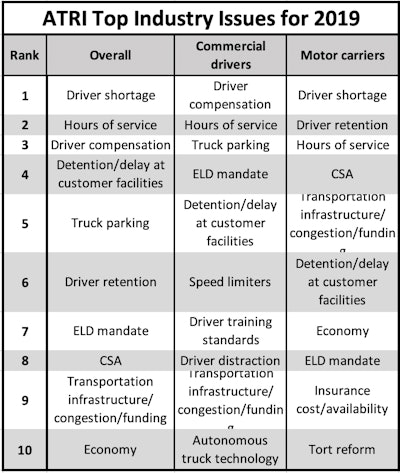
 The driver shortage tops ATRI’s list of top industry concerns for the fourth consecutive year.
The driver shortage tops ATRI’s list of top industry concerns for the fourth consecutive year.Despite softening freight conditions year-over-year and the accompanying capacity concerns, the driver shortage took the top spot in the American Transportation Research Institute’s annual Top Industry Issues survey. Driver-related issues ranging from truck parking to pay and detention time dominated this year’s list.
2019 marks the fourth consecutive year the driver shortage has claimed the top spot. The American Trucking Associations said the driver shortage reached an all-time high of 60,800 at the end of 2018 and the trendline forecasts a shortage of 160,000 drivers by 2028.
“The driver shortage is an over-the-road, for-hire truckload problem,” said Bob Costello, ATA’s chief economist and senior vice president. He doesn’t believe the 2028 trendline will occur, but if it does the industry and the overall economy will suffer, he says. “We will go from an operational hardship to real shortages at stores if we keep going down this path.
“There is no one reason for the driver shortage, so there is not one solution,” he added, citing the average age of 35 for driver trainees and comparatively low participation by women in the industry. Women make up 47 percent of the overall U.S. workforce, but they represent just 6 percent of the driver ranks in the industry.
Driver pay increases enacted across the board among large for-hire carriers the last two years have not done enough to mitigate the effects of the driver shortage. Driver compensation made its debut in the list as the No. 3 overall concern and No. 1 among driver respondents. (ATRI’s survey of more than 2,000 respondents included a 51 percent response rate from carriers and 35 percent from drivers.)
USA Truck increased its driver wages 6.5 percent year-over-year, but James Reed, president and CEO, says more needs to be done. “We all agree that drivers don’t get paid enough for the good work they do to move 70-plus percent of the freight in this country,” he said.
Costello added that wage increases have not been enough to improve drivers’ bottom lines. “Take-home pay for drivers has not gone up at the same pace as their pay rates have gone up,” he said. The average length of haul has dropped from 800 miles to 503 miles since 2000. “As a result, fleets that used to get 120,000 miles per year on their trucks now struggle to get 100,000 miles. That has an impact on the drivers as well. The pay rates have gone up, but if they aren’t driving as much their take-home pay hasn’t gone up at the same pace.”
Gary Helms, a professional driver for Covenant Transport and a captain for ATA’s America’s Road Team, said there are other ways for carriers to compensate their drivers besides monetary raises. “Personally, I need more than that,” he said. “I need to feel that the job that I’m doing is valued by my company to be content. I get what I need from the company I work for that creates a working environment and atmosphere that I am valued and appreciated.”
Also appearing for the first time in ATRI’s Top Industry Issues survey this year is detention/delay at customer facilities. The No. 4 concern reflects growing concern over excessive delays that create cascading impacts for drivers’ hours-of-service compliance, compensation and ability to find safe, available truck parking.
Rebecca Brewster, ATRI president and COO, cited research between 2014 and 2018 that found a 27.4 percent increase in delays of 6 or more hours.
“Probably the biggest issue from a business perspective is the interruption of hours of service,” said Reed. “Drivers waste an inordinate amount of time at the shippers.”
“I tell shippers that they can help themselves,” added Costello. “If they can turn loads around faster and drivers could get 250 more miles per week, that is an effective increase in capacity of more than 10 percent.”














